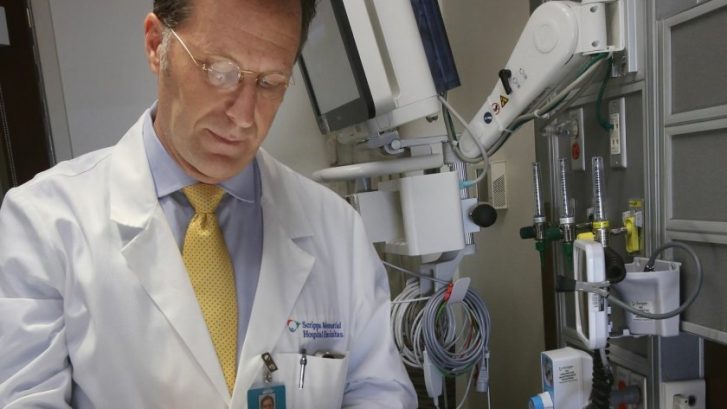Scripps Encinitas to open new ER
When Dr. Scott Eisman started working nights in the Scripps Memorial Hospital Encinitas emergency room during the 1980s, patients were few and far between. With two or three nightly visitors, there was even enough down time to play catch at a baseball field across the street.
Not any more.
“Now it is full almost 24 hours a day,” said Eisman, currently the hospital’s chief of staff. “There has been a tremendous growth in the community.”
To better accommodate increased demand for emergency-room beds in coastal North County from a rising population and the aging baby-boomer set, Scripps Encinitas plans to open a $94 million critical-care building today. The structure includes a new 26-bed emergency department — more than double the size of its predecessor.
North County’s population swelled by about 20 percent over the past decade, according to the San Diego Association of Governments. The hospital’s former emergency room, which hadn’t been expanded since 1991, couldn’t keep up.
Since 2000, the number of people visiting Scripps Encinitas’ emergency room soared more than 50 percent. Last year alone, the emergency department served just over 40,000 patients, compared with almost 27,000 patients in 2003.
“They were overbooked like a hotel that sold too many rooms,” said Tom Grant, 82, of Encinitas. He has visited the Scripps Encinitas emergency room several times and found an overflow crowd on each occasion. Grant said he and his wife, Mary Ellen, donated $1 million toward the new emergency department after seeing the need for a revamped facility.
In past years, the small emergency room forced doctors and nurses to place patients in different locations throughout the hospital — an inefficient system, Eisman said.
The new facility consolidates beds and equipment. Upon entering the waiting room, with its modern wood paneling and blue-and-gray stone walls, nurses take patients into rooms designed to assess the severity and urgency of an injury or illness, and then to private rooms for further care. Eisman expects the upgraded system to shorten treatment times.
For easy access, a CT scanner, an MRI scanner and digital diagnostic X-ray units are housed in the emergency department.
On the second floor, the new facility has 36 private surgical impatient rooms — including twelve that can be used for intensive care.
“It is very flexible,” Eisman said. “It really serves the different needs of the area.”
Scripps Encinitas is one of several medical centers in San Diego County to renovate or reconstruct its facilities in recent years. Palomar Health completed a 740,000-square-foot Palomar Medical Center in Escondido in 2012, while Kaiser Permanente in San Diego broke ground on its new hospital in February.
Hospitals must regularly remodel their infrastructure to keep up with changing technology and regulations, said Nate Kaufman, the managing director for Kaufman Strategic Advisors, a health-care consulting firm.
Many health providers are renovating or building new facilities in part to comply with a California law that requires hospitals to meet certain earthquake safety standards, Kaufman added.
Chris Van Gorder, chief executive for the Scripps Health network, said the state mandate to update facilities has not come without pain.
“This is probably the largest unfunded liability in the history of the state,” Van Gorder said. “It has been a huge burden for us and for hospitals throughout California.”
The new critical-care building at Scripps Encinitas is part of an expansion project financed by philanthropic donations, operational income and debt financing.
Scripps Health has worked to secure donations to help defray the cost of the Encinitas project, collecting about $40 million to date — including a $10 million contribution from the Leichtag Family Foundation, the network said.
Van Gorder hopes the public continues to donate toward the $58 million fundraising goal.
“We have found that people tend to donate after they can see what they’re donating for,” he said.
Staff writer Paul Sisson contributed to this report.


